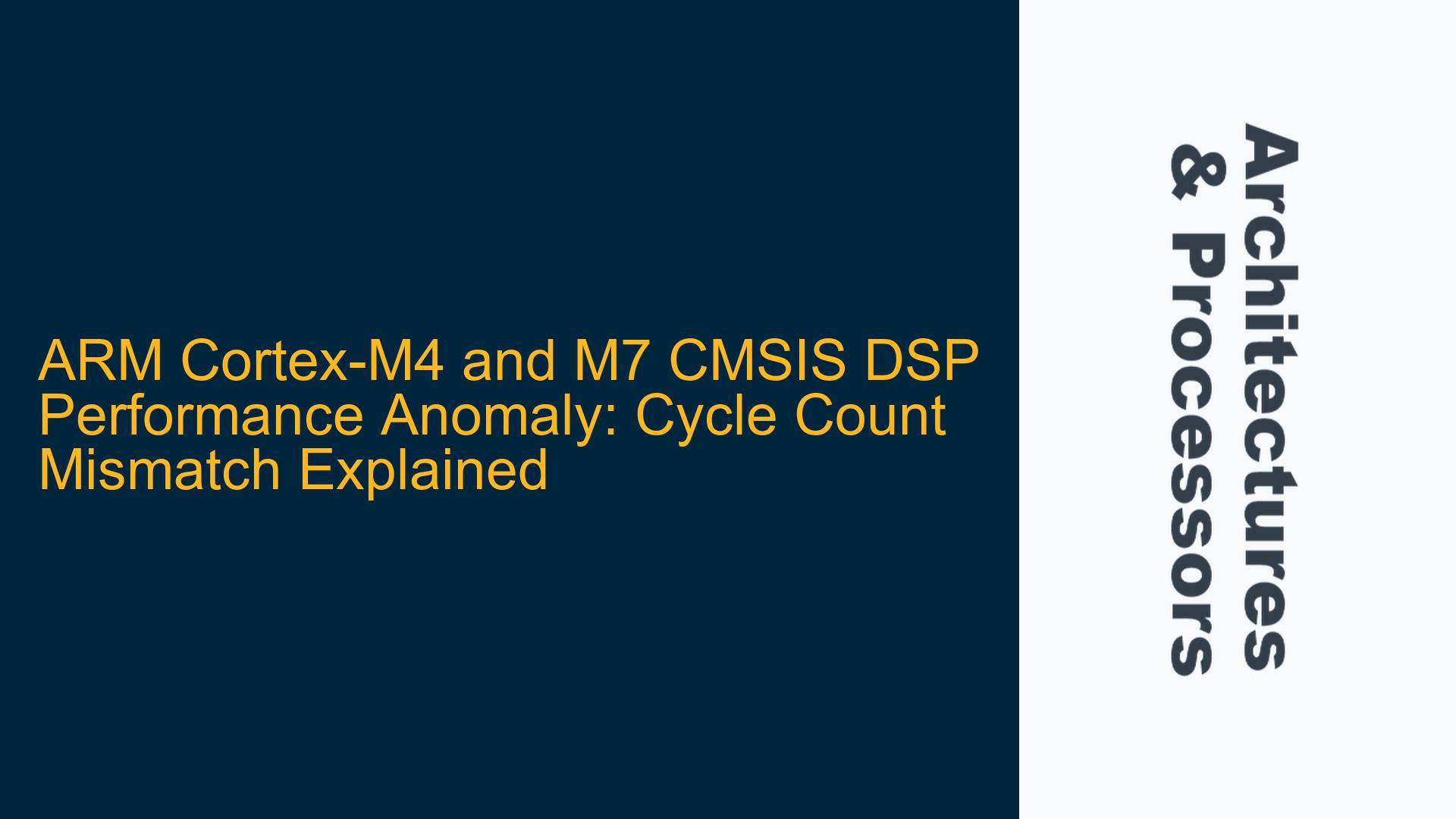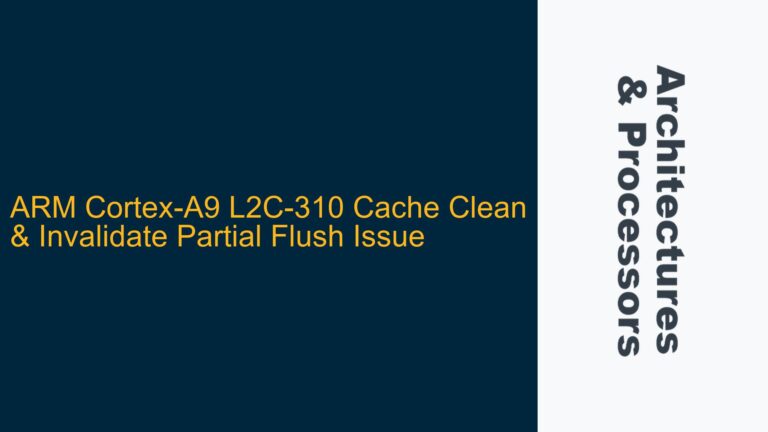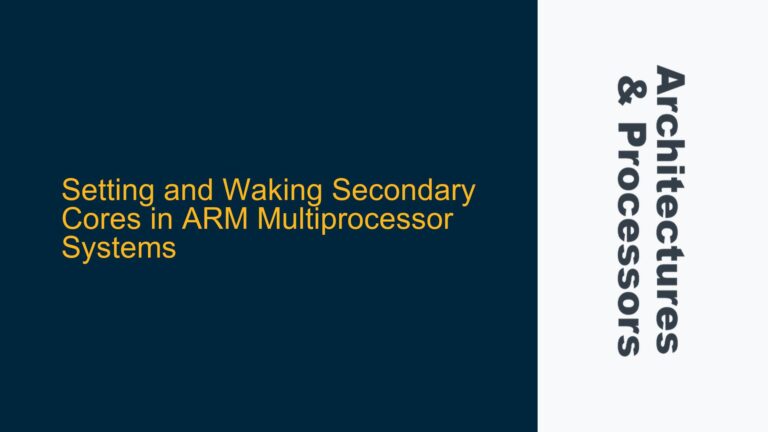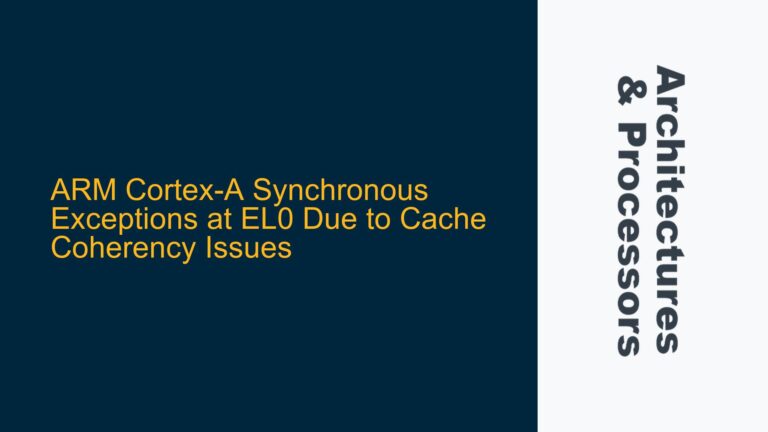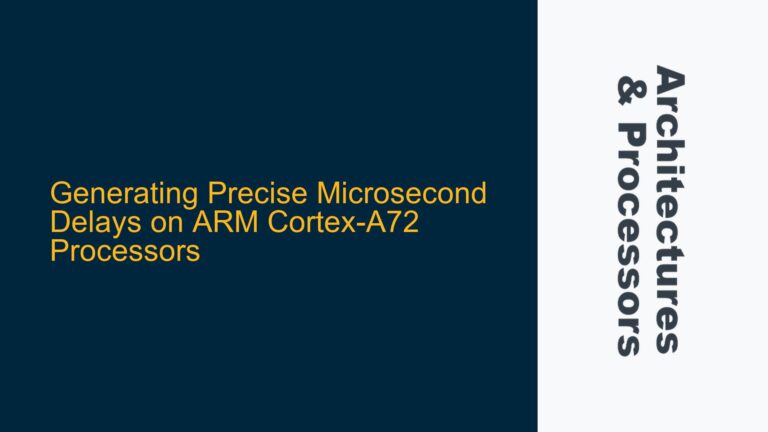ARM Cortex-M4 and M7 CMSIS DSP Function Cycle Count Discrepancy
When executing fixed-point CMSIS DSP functions such as arm_dot_q15 on both ARM Cortex-M4 and Cortex-M7 processors, it is expected that the Cortex-M7, with its superior performance characteristics, would demonstrate a lower cycle count compared to the Cortex-M4. However, in some cases, developers observe identical cycle counts for both processors, leading to confusion and questions about the underlying causes. This anomaly can be attributed to a combination of factors, including compiler optimizations, memory subsystem behavior, and the specific implementation of the CMSIS DSP library. Understanding these factors is crucial for diagnosing and resolving the issue.
The Cortex-M7 is architecturally more advanced than the Cortex-M4, featuring a dual-issue pipeline, optional double-precision floating-point unit (FPU), and higher clock speeds. These enhancements should theoretically result in faster execution of DSP functions. However, the observed parity in cycle counts suggests that certain bottlenecks or inefficiencies are preventing the Cortex-M7 from fully leveraging its capabilities. These bottlenecks could stem from memory access patterns, cache behavior, or suboptimal compiler settings.
To thoroughly investigate this issue, it is essential to examine the specific implementation of the arm_dot_q15 function, the memory layout of the data being processed, and the configuration of the development environment, including compiler flags and optimization levels. Additionally, the interaction between the Cortex-M7’s cache and the memory subsystem must be analyzed to identify potential performance inhibitors.
Compiler Optimizations and Memory Subsystem Behavior
One of the primary reasons for the identical cycle counts between the Cortex-M4 and Cortex-M7 lies in the compiler optimizations and the behavior of the memory subsystem. The CMSIS DSP library is designed to be highly optimized for ARM processors, but the extent of these optimizations can vary depending on the compiler and the target architecture. In some cases, the compiler may generate similar assembly code for both the Cortex-M4 and Cortex-M7, leading to comparable cycle counts.
The Cortex-M7’s dual-issue pipeline allows it to execute two instructions per cycle under optimal conditions. However, this capability is contingent on the availability of parallelizable instructions and the absence of pipeline stalls. If the compiler does not fully exploit the dual-issue capability, the Cortex-M7 may not achieve its potential performance gains. Additionally, the Cortex-M7’s cache behavior can significantly impact performance. If the data being processed by the arm_dot_q15 function is not efficiently cached, the processor may experience frequent cache misses, leading to increased memory access latency and reduced performance.
Another factor to consider is the memory layout of the input data. The Cortex-M7’s cache is designed to improve performance by reducing memory access latency, but this benefit is only realized if the data is accessed in a cache-friendly manner. If the data is scattered across non-contiguous memory locations or if the access pattern results in frequent cache line evictions, the Cortex-M7’s performance may be hindered. In contrast, the Cortex-M4, with its simpler memory subsystem, may be less affected by such issues, resulting in similar cycle counts.
Analyzing and Resolving Cortex-M7 Performance Bottlenecks
To address the performance discrepancy between the Cortex-M4 and Cortex-M7, a systematic approach is required to identify and resolve the underlying bottlenecks. The following steps outline a comprehensive troubleshooting process:
Step 1: Verify Compiler Settings and Optimization Levels
The first step is to ensure that the compiler is configured to generate optimized code for the Cortex-M7. This involves checking the compiler flags and optimization levels. For example, the ARM Compiler (armclang) and GCC provide various optimization flags that can significantly impact performance. Enabling optimizations such as -O3 (highest optimization level) and -mcpu=cortex-m7 (targeting Cortex-M7) can help the compiler generate more efficient code that leverages the Cortex-M7’s advanced features.
Additionally, it is important to verify that the compiler is generating code that takes advantage of the Cortex-M7’s dual-issue pipeline. This can be done by examining the generated assembly code and checking for the presence of parallelizable instructions. If the compiler is not generating dual-issue instructions, it may be necessary to manually optimize the code or use compiler-specific pragmas to guide the optimization process.
Step 2: Analyze Memory Access Patterns and Cache Behavior
The next step is to analyze the memory access patterns of the arm_dot_q15 function and the behavior of the Cortex-M7’s cache. This can be done using profiling tools that provide insights into cache hits and misses, memory access latency, and data locality. Tools such as ARM’s Streamline Performance Analyzer or Lauterbach’s TRACE32 can be used to collect and analyze this data.
If the profiling data indicates frequent cache misses or inefficient memory access patterns, it may be necessary to reorganize the data layout or modify the access pattern to improve cache utilization. For example, aligning data structures to cache line boundaries and accessing data in a sequential manner can reduce cache misses and improve performance. Additionally, enabling the Cortex-M7’s data cache prefetching mechanism can help mitigate memory access latency by preloading data into the cache before it is needed.
Step 3: Evaluate CMSIS DSP Library Implementation
The final step is to evaluate the implementation of the CMSIS DSP library and its interaction with the Cortex-M7. The CMSIS DSP library is designed to be highly optimized, but there may be opportunities for further optimization, especially when targeting the Cortex-M7. This involves examining the source code of the arm_dot_q15 function and identifying any potential inefficiencies.
One area to focus on is the use of SIMD (Single Instruction, Multiple Data) instructions. The Cortex-M7 supports SIMD instructions through its DSP extension, which can significantly accelerate DSP operations. If the arm_dot_q15 function is not fully utilizing SIMD instructions, it may be possible to rewrite the function to take advantage of these capabilities. Additionally, the use of intrinsic functions provided by the CMSIS DSP library can help optimize critical sections of the code.
Step 4: Implement Data Synchronization Barriers and Cache Management
In some cases, the Cortex-M7’s performance may be hindered by improper cache management or the lack of data synchronization barriers. The Cortex-M7’s cache is managed through a set of cache control registers, and it is important to ensure that the cache is properly configured and maintained. This includes invalidating the cache before accessing new data and cleaning the cache after modifying data to ensure consistency with main memory.
Data synchronization barriers (DSB) and instruction synchronization barriers (ISB) are used to enforce the order of memory accesses and ensure that the processor’s pipeline is properly synchronized. If these barriers are not used correctly, the Cortex-M7 may experience pipeline stalls or incorrect results. Adding appropriate DSB and ISB instructions to the arm_dot_q15 function can help improve performance and ensure correct operation.
Step 5: Benchmark and Validate Performance Improvements
After implementing the above optimizations, it is important to benchmark the performance of the arm_dot_q15 function on both the Cortex-M4 and Cortex-M7 to validate the improvements. This involves measuring the cycle count and comparing it to the original results. If the optimizations are successful, the Cortex-M7 should demonstrate a lower cycle count compared to the Cortex-M4, reflecting its superior performance capabilities.
In addition to cycle count, other performance metrics such as execution time, cache hit rate, and memory bandwidth should be measured to gain a comprehensive understanding of the system’s performance. These metrics can help identify any remaining bottlenecks and guide further optimization efforts.
Conclusion
The observed parity in cycle counts between the ARM Cortex-M4 and Cortex-M7 when executing the arm_dot_q15 function can be attributed to a combination of compiler optimizations, memory subsystem behavior, and the specific implementation of the CMSIS DSP library. By systematically analyzing and addressing these factors, it is possible to unlock the full performance potential of the Cortex-M7 and achieve the expected performance gains over the Cortex-M4.
The key to resolving this issue lies in understanding the interaction between the Cortex-M7’s advanced architectural features and the specific requirements of the DSP function. By optimizing compiler settings, improving memory access patterns, leveraging SIMD instructions, and properly managing the cache, developers can ensure that the Cortex-M7 delivers superior performance in DSP applications.
